Biology unit 7 test
5.0(1)
5.0(1)
Card Sorting
1/64
Study Analytics
Name | Mastery | Learn | Test | Matching | Spaced |
|---|
No study sessions yet.
65 Terms
1
New cards
What are the four major categories of geologic time (from largest to smallest)?
Eon, Era, Period, Epoch
2
New cards
What are the 3 eras?
Paleozoic, Mesozoic, and Cenozoic
3
New cards
What age are each of the eras?
* Paleozoic: Age of Ancient Life
* Mesozoic: Age of Reptiles
* Cenozoic: Age of Mammals (current)
* Mesozoic: Age of Reptiles
* Cenozoic: Age of Mammals (current)
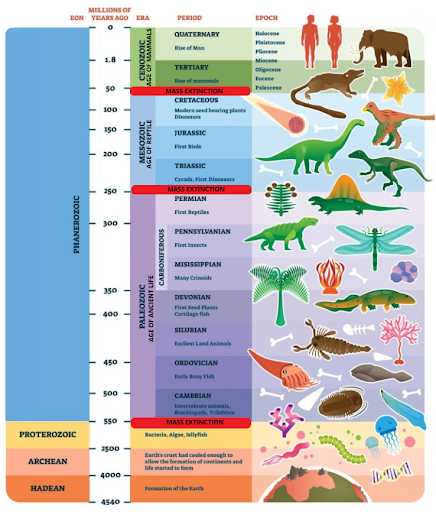
4
New cards
How many extinctions have there been so far? (that we were taught to care about for this unit, ignore the extra mass extinctions)
3
5
New cards
What is relative age?
Geologists use the Law of Superposition and Index Fossils to determine an approximate age of a sample.
6
New cards
What is the law of superposition?
The Law of Superposition states that younger rocks are located in layers above older rocks.
7
New cards
What are index fossils?
A fossil of characteristic rock and a known age that can be used to determine the relative age of other fossils
8
New cards
What is absolute age?
Geologists use radioactive dating to measure the absolute age of a sample. Half life, the unit of measure compares radioactive to non radioactive elements in a sample. Carbon dating is a type of radioactive dating.
9
New cards
How old is the Earth?
4\.6 billion years old
10
New cards
What did the Earth’s early atmosphere include and what was it like?
* Carbon dioxide
* Water Vapor
* Nitrogen
* Methane
* Ammonia
* WAMNC acronym
* Hot, unstable and extreme weather conditions
* Water Vapor
* Nitrogen
* Methane
* Ammonia
* WAMNC acronym
* Hot, unstable and extreme weather conditions
11
New cards
How were the oceans formed?
Simple: water vapor cooled.
\
Complex: After about 2.0 billion years, the earth began to cool allowing the oceans to form. A large amount of carbon dioxide settled in the ocean and created places for life to thrive. This is when the first prokaryotes emerged.
\
Complex: After about 2.0 billion years, the earth began to cool allowing the oceans to form. A large amount of carbon dioxide settled in the ocean and created places for life to thrive. This is when the first prokaryotes emerged.
12
New cards
When the oceans cooled, what happened to much of the atmospheric carbon dioxide?
It settled to the bottom of the ocean
13
New cards
What was the purpose of Miller and Urey’s experiment?
The purpose of the experiment was to see if the ingredients in the early Earth could make the organic compounds necessary for life.
14
New cards
What did their experiment conclude?
It showed that the organic compounds necessary for life could have arisen from the ingredients present on an early earth.
15
New cards
What was life like, and how did it evolve?
First life: Heterotrophic, Anaerobic Prokaryotes
Life evolved: Autotrophic, Anaerobic Prokaryotes
**Chemo**synthesis: Using chemicals to make food
Ex: Hot sulfur springs, harsh environments
Life evolved: Autotrophic, Aerobic Prokaryotes
**Photo**synthesis: Using light to make food
\
Definitions:
* Anaerobic: respiration WITHOUT oxygen
* Aerobic: respiration WITH oxygen
* Heterotrophic: organism that cannot produce its own food
Life evolved: Autotrophic, Anaerobic Prokaryotes
**Chemo**synthesis: Using chemicals to make food
Ex: Hot sulfur springs, harsh environments
Life evolved: Autotrophic, Aerobic Prokaryotes
**Photo**synthesis: Using light to make food
\
Definitions:
* Anaerobic: respiration WITHOUT oxygen
* Aerobic: respiration WITH oxygen
* Heterotrophic: organism that cannot produce its own food
16
New cards
More in-depth explanation of the previous card
* The first organisms were thought to be __heterotrophic__ prokaryotes that were __anaerobic__ because there was no oxygen present in earth’s atmosphere.
* Then came the __autotrophic__ prokaryotes similar to present-day archaebacteria. These prokaryotes live in harsh conditions with little sunlight and oxygen such as hot sulfur springs. \*\*This type of food synthesis is known as **CHEMOSYNTHESIS.**
* Next, came the __aerobic__ autotrophic prokaryotes. This began to change our atmosphere and allowed for the evolution of organisms that could __aerobically__ respire. According to the fossil record, the “ oxygen revolution” occurred about 2.8 billion years ago. \*\*This type of food synthesis is known as **PHOTOSYNTHESIS.**
* Then came the __autotrophic__ prokaryotes similar to present-day archaebacteria. These prokaryotes live in harsh conditions with little sunlight and oxygen such as hot sulfur springs. \*\*This type of food synthesis is known as **CHEMOSYNTHESIS.**
* Next, came the __aerobic__ autotrophic prokaryotes. This began to change our atmosphere and allowed for the evolution of organisms that could __aerobically__ respire. According to the fossil record, the “ oxygen revolution” occurred about 2.8 billion years ago. \*\*This type of food synthesis is known as **PHOTOSYNTHESIS.**
17
New cards
What is the Endosymbiotic theory?
Eukaryotic cells arose from living communities formed by prokaryotic organisms.
18
New cards
Why must multicellular organisms sexually reproduce?
Multicellular organisms are more complex than single-celled organisms and need to increase the probability that favorable genes will be passed on.
19
New cards
What are the advantages of reproducing sexually?
The advantage of sexually reproducing is that it increases genetic variability.
20
New cards
Charles Darwin
Came up with the theory of evolution, published Origin of Species. He came up with his theory because he visited the Galapagos Islands, and noticed similar species of birds that were adapted to their individual islands.
21
New cards
What is natural selection?
When nature (the natural environment) selects which organisms survive long enough to reproduce.
22
New cards
what are the two key ingredients to natural selection?
Reproduction and variation.
23
New cards
What does “the fittest” mean in an evolutionary sense?
The most reproductively successful (has the most offspring that live)
24
New cards
Is evolution random?
Evolution is neither entirely fixed nor entirely random.
25
New cards
what is the goal of the “tree of life”?
To explain how all species are related to each other.
26
New cards
What did Darwin’s theory of evolution attempt to explain?
Species change over time
27
New cards
What did Darwin believe?
Darwin believed that all forms of life descended from a common ancestor.
28
New cards
four components of natural selection
Heredity, overproduction, selection or death, variation
29
New cards
In the 19th century, in London, a pale peppered moth was more common than the black moth. As the industrial revolution took place and soot covered buildings and trees, the black moth became more common. Why did this happen?
Because the soot from the factories made the tree trunks darker, meaning that the lighter moths could be seen more easily and the darker ones were now harder to find.
30
New cards
Lamarck suspected that animals “improved” themselves. What did he believe that a giraffe’s long neck was the result of?
The giraffe stretching to reach food higher off the ground. Lamarck also believed these “acquired” traits were passed onto the next generation.
31
New cards
Darwin, on the other hand, believed in Descent with Modification. What is Descent with Modification?
Populations change as characteristics that allow individuals to survive are selected for. He also believed that the traits of the parents were passed on to their offspring without being modified by the parents.
32
New cards
Darwin realized the importance of the fact that, in any population of living organisms, there already exists ____ in any given characteristic.
variation.
33
New cards
According to Darwin, what does fitness mean?
the ability of an individual to survive and to pass on its characteristics to the next generation.
34
New cards
Darwin proposed that the changes within a species occurred ___ through a ___ process.
very slowly, gradual
35
New cards
How do new species arise?
As needs, adaptations and differences within a species increases, the organisms become more different from each other.
Once a connecting species (the average) disappears, the species are too different and they cannot interbreed to produce a fertile offspring anymore.
Once a connecting species (the average) disappears, the species are too different and they cannot interbreed to produce a fertile offspring anymore.
36
New cards
Adaptive radiation
the diversification of a group of organisms into forms filling different ecological niches.
37
New cards
Convergent Evolution
the process by which unrelated organisms evolve similarly to live in a similar environment
38
New cards
Divergent Evolution
origin from a common ancestor
39
New cards
Reproductive Isolation
Factors that prevent organisms from reproducing with each other
40
New cards
Geographic isolation
* Also known as allopatric speciation
* When a geographic barrier separates a group of species.
* As time passes, the environment may require different traits and the 2 populations become genetically different __**AND**__ cannot reproduce
* When a geographic barrier separates a group of species.
* As time passes, the environment may require different traits and the 2 populations become genetically different __**AND**__ cannot reproduce

41
New cards
Habitat isolation
When organisms in the same general area adapt to different habitats. Ex: a snake that lives in the water vs a snake that lives on land
42
New cards
Temporal isolation
* Time-based isolation when individuals reproduce at different times.
* This is more common for organisms that mate during specific times of the day or year.
* This is more common for organisms that mate during specific times of the day or year.
43
New cards
Behavioral Isolation
if 2 populations have different courtship behaviors, they will not be able to interbreed.
* Different songs (birds)
* Different mating calls (frogs)
* Different scents (smells)
* Different songs (birds)
* Different mating calls (frogs)
* Different scents (smells)
44
New cards
Which isolations are known as sympatric speciation?
* Habitat Isolation
* Temporal Isolation
* Behavioral Isolation
Sympatric Speciation - living in the same location
* Temporal Isolation
* Behavioral Isolation
Sympatric Speciation - living in the same location
45
New cards
Punctuated Equilibrium
Organisms go through fast periods of change, followed by long periods of no change
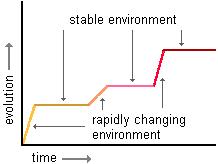
46
New cards
Gradualism
Organisms will go through a gradual and continuous change
47
New cards
Species
organisms that can interbreed (reproduce) and produce fertile offspring
48
New cards
Population
A group of the same species, living in the same area, that interbreed
49
New cards
What contributes to the shift of traits within a population?
Natural selection
50
New cards
What are the the 3 ways natural selection can affect the distribution of trait phenotypes in a population?
* Directional Selection
* Stabilizing Selection
* Disruptive Selection
* Stabilizing Selection
* Disruptive Selection
51
New cards
Directional selection
Choosing for one extreme, choosing against the opposite extreme.
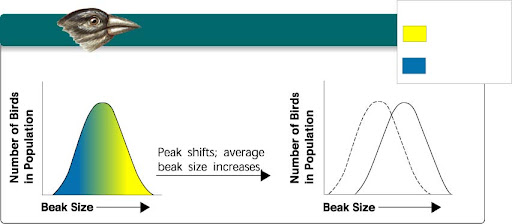
52
New cards
Stabilizing selection
Choosing for average, choosing against the extremes.

53
New cards
Disruptive selection
Choosing for the extremes, choosing against the average. Can eventually cause two different species since there is no connecting species connecting the two extremes.
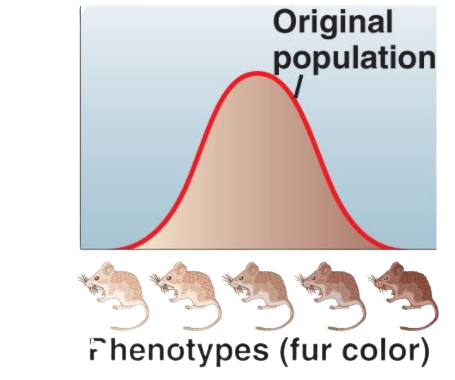
54
New cards
Genetic drift
a random change in the frequency of an allele. It is the opposite of natural selection.

55
New cards
Conditions needed for Hardy Weinberg equations
1. The __**population**__ **must be** __**large**__ so that no genetic drifts can affect the population
2. __**Random**__ __**mating**__ **must** __**occur**__ so each individual has an equal chance of passing a trait.
3. __**No**__ __**selection**__ **of** __**traits**__ can occur.
4. __**No**__ __**mutations**__ must occur within the population.
5. __**No**__ __**migration**__ in and out of an area can occur.
56
New cards
What are the 4 categories of evidence?
1. Fossil Evidence
2. Comparative Anatomy
3. Embryology
4. Biochemistry (DNA)
57
New cards
Fossil evidence
The most common method of fossilization is petrification
When an organism dies, it is buried under
many layers of sediment and sand.
Water seeps into the bones, replacing the bone
material with minerals.
Over time, all of the bone is replaced with minerals and eventually becomes rock.
Other methods for preservation are: ice, tar and amber
When an organism dies, it is buried under
many layers of sediment and sand.
Water seeps into the bones, replacing the bone
material with minerals.
Over time, all of the bone is replaced with minerals and eventually becomes rock.
Other methods for preservation are: ice, tar and amber
58
New cards
Homologous structures
Similar in form/location, but different in function. Evidence of divergent evolution. Origin from a common ancestor
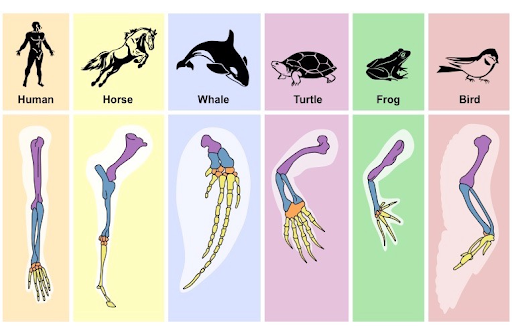
59
New cards
Analogous structures
Similar in function but different in structure. Evidence of convergent evolution. Similarities in body due to environment not a common ancestor
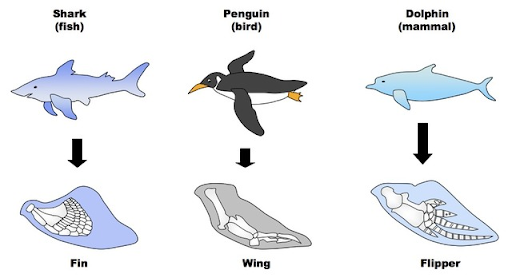
60
New cards
Vestigial structures
Organs remaining or surviving in an organism that are no longer used in the same way as previous generations. Evidence suggests that populations have changed over time.
Human Examples: wisdom teeth, tail bone, appendix
Human Examples: wisdom teeth, tail bone, appendix
61
New cards
The previous 3 cards have been what type of evidence of evolution.
Comparative anatomy
62
New cards
Embryology
Studying developmental stages gives some clue to evolutionary relationships. General characteristics form before developing into specific traits
* Examples
* Limb Buds
* Gill Slits
* Tail
* Examples
* Limb Buds
* Gill Slits
* Tail
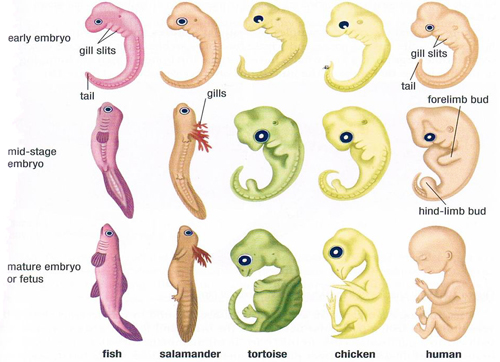
63
New cards
Biochemistry/ DNA Evidence
The more similar the DNA (or amino acids in a protein), the more closely related the organisms. EX: the matching sequence LYS-GLU-HIS-ISO between a human and a chimpanzee.
64
New cards
Endogenous Retroviruses
* Virus infects egg/sperm cell
* Viral DNA passed onto offspring
* Viral DNA is passed on to many generations
* Can link similar species with the same viral DNA sequences to a common ancestor
* Ex: Chromosome comparison shows 100’s of similarities in the placement of viral DNA of chimpanzee and human chromosomes, suggesting a common ancestor
* Viral DNA passed onto offspring
* Viral DNA is passed on to many generations
* Can link similar species with the same viral DNA sequences to a common ancestor
* Ex: Chromosome comparison shows 100’s of similarities in the placement of viral DNA of chimpanzee and human chromosomes, suggesting a common ancestor
65
New cards
how the lab that we did in this unit show Darwin’s principles: Mechanisms of Evolution (with the beans)
it showed how an organism needs food to survive, and when others fall behind in terms of food, the gene that is allowing an organism to survive and get more food gets passed on, allowing for the gene to better itself and for that to get passed down too.